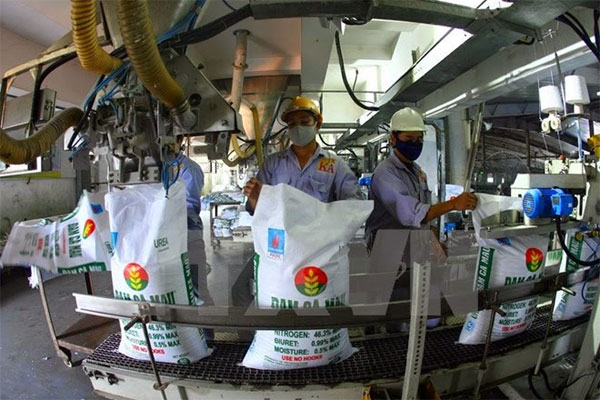VietNamNet Bridge – The prevalence of fake and substandard fertilisers is a pressing issue that has caused economic losses worth billions of dollars and turned the livelihoods of many farmers upside down.

|
|
Workers package nitrogen fertilisers at the Ca Mau gas-power-fertiliser complex in the southernmost province of Ca Mau.
|
A year ago, Nguyen Van Thuy, a farmer in Dak Nong Province’s Truong Xuan Commune, spent VND60 million (US$2.690) buying three-component fertilisers known as NPK to grow his coffee garden. Instead of growing further, his coffee trees became thinner and their leaves fell off.
“I had to cut down the trees that I had been growing over the last four to five years,” Thuy told VTV.
He believes that substandard fertilisers harmed his crops.
“This is too much for us,” he said. “I worked very hard to make money to buy the fertiliser, but now most of the trees have died.”
Losing crops due to fake and substandard fertilisers is a common issue among farmers in recent years.
Do Duy Nhat, a member of the managing board of the Viet Nam Pepper Association told VTV: “Some members in our association have gone broke after using fake fertilisers.”
“We don’t know what else to do but offer condolences and instruct them to recover as much of their crops as possible,” he said.
The failed seasons of last year caused a loss of $2.5 billion for the agricultural sector.
Each year, the market management department under the Ministry of Industry and Trade unveil some 4,000 cases of producing and trading fake and substandard fertilisers.
Based on statistics from the Viet Nam Fertiliser Association, the country currently has some 7,000 types of fertilisers, while there are only 300 standard types in the world.
Speaking at a national convention on regulating the fertiliser market in Ha Noi last week, Nguyen Huy Cuong, deputy director general of the Department of Crop Production under the Ministry of Agriculture and Rural Development, said that the excessive number of fertilisers made him unable to discern the real from the fake ones.
“Fake fertilisers have got so refined, but there aren’t any strict measures against those who produce them,” he said. “None of the authorities have issued regulations that specify the difference between real and fake fertilisers, either. It puts farmers in a bind.”
Lai Xuan Mon, chairman of the Viet Nam Farmer Association, said that fake and substandard fertilisers made up 30-50 per cent of the fertilisers in the market.
The presence of thousands of brands confuses farmers, Luong Quoc Doan, vice chairman of the association, said.
“There is no way they can understand and remember all the fertilisers’ effects, let alone discern the difference between the real and fake ones,” he said. “This is a loophole that cheaters can take advantage of to delude farmers.”
Too many products have created excessive competition, which has led enterprises to compromise on product quality to survive in the market, said Bui Manh Tien, general manager of the Ca Mau Fertiliser Plant.
Responsibility revamp
Regulations on fertiliser management were stated in the Government’s Decree No 202 issued in 2013. However, since it required both the agricultural ministry and the trade ministry to take part in the management process, there were management overlaps between the two ministries.
Fertiliser enterprises, suppliers and market management units did not know which ministry they should turn to when troubles arose.
While some experts proposed that a single ministry should take charge of fertiliser management, Nguyen Dang Nghia, director of the Tropical Agricultural Research and Consultancy Centre, suggested keeping both ministries involved, but further clarifying the responsibilities of each.
The trade ministry should be responsible for issuing licences after assessing enterprises on their size, equipment, production materials and environmental-friendliness, he suggested. The agricultural ministry should compose a list of all fertilisers in the market, from which enterprises would compete against one another by quality, design and packaging.
Nghia also stressed that it required capable, devoted officials to eradicate fake products. Those who participated in the fertiliser management process should have a knowledge of fertilisers and working experiences in this sector.
Nguyen Hac Thuy, general secretary of the Viet Nam Fertiliser Association, pointed out that it was not only the responsibility of the production units and suppliers to stand against substandard fertilisers, but also the responsibility of testing centres.
He questioned why many poor-quality fertilisers passed the tests.
In May, the Ministry of Agriculture and Rural Development withdrew the licences of eleven testing centres for violating several regulations on fertiliser certification.
One of the centres certified some 500 types of fertiliser that did not meet the agricultural ministry’s standards, 1,200 fertilisers that were beyond the scope of its expertise and some 270 production units without supervising their production process.
| related news |
|
Fake fertilisers flood VN market |
VNS